Previously, we looked at the stories of four women art dealers active in Britain and Europe. This time, we’ll be adding three more important figures to the narrative, looking at women dealers working in America.
Edith Halpert (1900 – 1970)
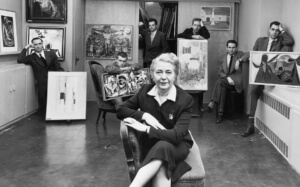

Edith Halpert in a photograph for Life magazine, 1952. She is joined by artists Charles Oscar, Robert Knipschild, Jonah Kinigstein, Wallace Reiss, Carroll Cloar and Herbert Katzman. Courtesy of The Jewish Museum
Edith Halpert – originally Edith Gregoryevna Fivoosiovitch, from Odessa, then part of Russia – became a pioneering New York dealer of American and American folk art. Her Downtown Gallery, was founded in Greenwich Village in 1926 at a time when commercial galleries were all uptown. Halpert’s gallery was also the only one at the time dedicated to the work of living American artists, among them Stuart Davis, Charles Sheeler, Marsden Hartley, Arthur Dove, Jacob Lawrence, John Marin and Georgia O’Keeffe. In 1929 Halpert expanded the scope of the gallery’s dealings to focus on 19th century American and folk art as well, selling pieces by Raphaelle Peale, John Frederick Peto and William Michael Harnett.
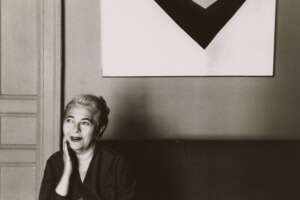

Edith Halpert with Georgia O’Keeffe’s In the Patio IX. Courtesy of the Jewish Museum
Halpert had originally trained as an artist herself after arriving in New York, having fled the pogroms with her mother and older sister, and in 1917 she had married fellow painter Samuel Halpert. Although the two divorced in 1930, they socialised among colleagues in lively artists’ communities in Paris and Ogunquit, Maine. Through her friendship with Abby Aldrich Rockefeller, Halpert was able to persuade Rockefeller to provide support for the founding of a Museum of Modern Art in 1929.
Holly Solomon (1934 – 2002)
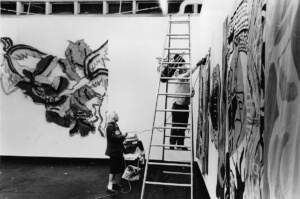

Holly Solomon hanging works by Robert Kushner at the Holly Solomon Gallery, 1981. Courtesy of Thomas Solomon
Self-appointed ‘Pop princess’, collector, patron and dealer Holly Solomon’s SoHo gallery, founded in 1975, fiercely supported Contemporary art of the 60s, 70s and 80s. She championed an eclectic, visual aesthetic including artists from the Pattern and Decoration movement (‘P and D’), a reaction against Minimalism. Many of the artists, including Judy Pfaff, Joan Mitchell, Cora Cohen, Melissa Miller and Miriam Schapiro, were women, and subscribed to a shared belief that art – whether in sculptural or painted form – should combine sophistication and wit, as well as being enjoyable in a collection. In 1969, together with her husband Horace Solomon, Holly opened the 98 Greene Street Loft. An alternative art and performance space, which supported the early careers of artists including Laurie Anderson, Robert Mapplethorpe, William Wegman and Gordon Matta-Clarke, the Loft addressed contemporary issues such as environmental re-use, regeneration, political activism, gender roles, and feminism.
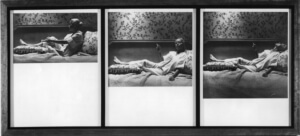

R. Mapplethorpe, Holly Solomon (Three Portraits), 1976
Solomon, a petite and feisty figure with a superb eye for fashion and jewellery, had a penchant for commissioning self-portraits from her protégés: among them are a nine-panel work by Warhol in which Solomon appears vamping in a photo booth (1966); a photograph of Solomon smoking in bed by Robert Mapplethorpe (1976); and a wrapped portrait by Christo (1966). Solomon’s taste was considered radical at the time, and her influence as a trendsetter continues to be honoured by exhibitions including Hooray for Hollywood! at Mixed Greens and Pavel Zoubo (2014), and Selected Works from the Collection of Holly Solomon 1968 – 1981, curated by Solomon’s son Thomas, at Marlborough (2019).
Peggy Guggenheim (1898 – 1979)
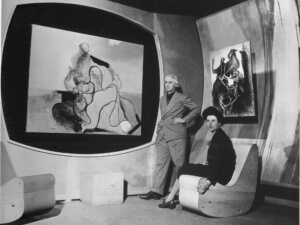

Peggy Guggenheim and Max Ernst, 1942, Art of this Century, New York
Although we have already met American heiress Peggy Guggenheim in the context of her identity as a collector and museum benefactress, Guggenheim also worked as an art dealer. She opened her first modern art gallery, Guggenheim Jeune, in London in January 1938, and made a habit of purchasing at least one piece from each of her own exhibitions. Although Guggenheim Jeune was well-reviewed and attended – and racked up such notable events as Kandinsky’s first solo show in Britain, and exhibitions of work by Yves Tanguy, Alexander Calder, Jean Arp, Picasso, Braque and others – it lost money, and Guggenheim closed the business in June 1939.
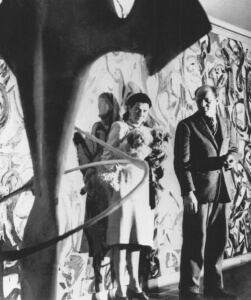

Peggy Guggenheim and Jackson Pollock in front of his Mural, c. 1946, New York
When she found herself in New York in summer 1941, Guggenheim again opened a gallery-museum, this one called The Art of This Century, which helped to advance the careers of important modernists including Jackson Pollock. Guggenheim also staged a show dedicated to 31 Women artists – the 31st, a late addition, was Dorothea Tanning, for whom Guggenheim’s husband Max Ernst left her.


